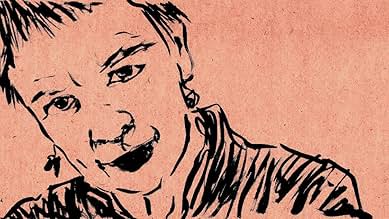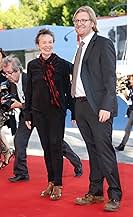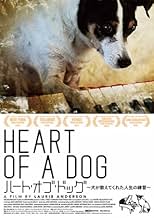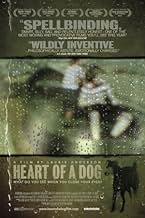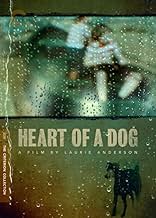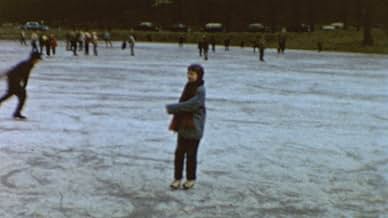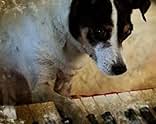VALUTAZIONE IMDb
7,0/10
2669
LA TUA VALUTAZIONE
Aggiungi una trama nella tua linguaMultimedia artist Laurie Anderson reflects on her relationship with her beloved terrier Lolabelle.Multimedia artist Laurie Anderson reflects on her relationship with her beloved terrier Lolabelle.Multimedia artist Laurie Anderson reflects on her relationship with her beloved terrier Lolabelle.
- Regia
- Sceneggiatura
- Star
- Premi
- 4 vittorie e 13 candidature totali
Dustin Guy Defa
- Gordon Matta-Clark
- (as Dustin Defa)
Jess Irish
- Nurse
- (as Jessica Irish)
Recensioni in evidenza
Heart of a dog is one of the most moving and interesting art movies I have ever seen. The story seems to be about the rat terrier Lollabelle but when the story begins there is that absurd tale of Laurie giving birth to the dog after surgeons have implanted the dog in her uterus and when it ends you realize that is really about a mother/daughter relation. The poetry in the movie is beautiful and absurd as ever and the images are stunning. You get really drawn into the story. Like her mother said in her last words; "Take care of the animals". Laurie did take care of her animal.
I had to watch this a few times to get everything I could out of it. I will tell you if you are expecting some kind of tribute to Ms. Anderson's dog in the vein of "Marley and Me", then you are going to be very disappointed. Instead Ms. Anderson weaves in stories about her dog, her Buddhist beliefs, her past back to her childhood, and the growth of the surveillance state into one very interesting piece. At the point where her dog, rat terrier Lolabelle, dies, the dog exits the narrative.
The opening pretty much gives you an idea of how avant-garde things are going to get, because it is about a dream she has where she has her dog sewn into her stomach by surgeons so that she can give birth to her. There are fun things that anybody could enjoy such as dogs wearing sandals - apparently this is a "thing" in Asia, and how Lolabelle went blind in her old age, and afterwards Ms. Anderson put some keyboards on the floor so the dog could "learn to play". The terrier actually got pretty good at "playing". Lolabelle actually did charity performances and even a Christmas album! I guess the one thing I really noticed is how Ms. Anderson is so unquestioning of her Buddhist beliefs and teachers. Case in point -when her dog got to the end of life and was in pain, the vets were recommending euthanasia. Ms. Anderson consults a Buddhist teacher who said that death is a process and you have no right to interfere with that process with either humans or animals. So unquestioning of that unconventional path, she took Lolabelle home from the vets - I'm hoping with tranquilizers and pain killers for her - and let her die on the living room floor in her regular dog bed.
Is this just a "thing" Americans have? (I'm American by the way) Whatever spiritual advice they are given by their chosen religion they follow it, regardless of common sense or compassion? I guess the fact that the piece raised questions with me is a good thing. I will say the visuals are very well done and Ms. Anderson has a calm and soothing voice. Not for everybody, but I would give it a chance. In fact, you'll probably have to give it several chances to get it.
The opening pretty much gives you an idea of how avant-garde things are going to get, because it is about a dream she has where she has her dog sewn into her stomach by surgeons so that she can give birth to her. There are fun things that anybody could enjoy such as dogs wearing sandals - apparently this is a "thing" in Asia, and how Lolabelle went blind in her old age, and afterwards Ms. Anderson put some keyboards on the floor so the dog could "learn to play". The terrier actually got pretty good at "playing". Lolabelle actually did charity performances and even a Christmas album! I guess the one thing I really noticed is how Ms. Anderson is so unquestioning of her Buddhist beliefs and teachers. Case in point -when her dog got to the end of life and was in pain, the vets were recommending euthanasia. Ms. Anderson consults a Buddhist teacher who said that death is a process and you have no right to interfere with that process with either humans or animals. So unquestioning of that unconventional path, she took Lolabelle home from the vets - I'm hoping with tranquilizers and pain killers for her - and let her die on the living room floor in her regular dog bed.
Is this just a "thing" Americans have? (I'm American by the way) Whatever spiritual advice they are given by their chosen religion they follow it, regardless of common sense or compassion? I guess the fact that the piece raised questions with me is a good thing. I will say the visuals are very well done and Ms. Anderson has a calm and soothing voice. Not for everybody, but I would give it a chance. In fact, you'll probably have to give it several chances to get it.
In her poetic film collage essay, Laurie Anderson is more beautifully and thoughtfully herself than ever. She has had a long career, but was most well-known in the 80's as an experimental performance artist, composer, and musician who especially explored the mix of spoken word and music. Those who know her albums such as "Big Science" and "Home of the Brave" will appreciate the return of the fragmented rhythm and quizzical tone of Anderson's speech, opening with voice-over sentences such as "This is my dream body – the one I use to walk around in my dreams."
Despite the film's seemingly stream-of-conscious, no-plot, hodge- podge approach, Anderson has meaningful ideas to express, and she's woven together an elegant and smartly structured tone-and-picture poem. The movie combines her personal stories and musings with quotations from renowned philosophers, ink drawings on paper, printed words, animation, scratchy old 8mm home-movie clips, new footage of landscapes, surveillance camera footage with time codes, graphic images such as computer icons, and her ingenious use of music. As always, Anderson excels at language, and here she combines various types of on-screen text with her own lyrical voice-over. I often leave a movie wanting to run home and download the soundtrack, but in this case I am yearning for a transcript. These are words worthy of reading and contemplating. "Try to learn how to feel sad without being sad," is just one of the many sentences that could use more time to resonate than one viewing allows.
But one of the surprises of this project may be Anderson's sophisticated and inventive cinematography. As the film explores a variety of deaths – the death of Anderson's dog, the death of her mother, the death of her husband (Lou Reed), and the mass deaths of 9/11 in New York, it seems the movie is often shedding its own tears. Many sequences are shot through a pane of glass that is dripping with water, like life itself is crying. And then she turns footage of an ocean upside down, with the foreground still raining, so the sea that has become the sky is weeping too. In front of everything, Anderson seems to be saying, is a gentle, pervasive sadness.
And yet, the movie is not even remotely maudlin. It discusses 9/11 in way that actually adds fresh insight, which seems impossible after so many anniversaries full of remembrance ceremonies, and so many other films that have also integrated that tragic event.
Perhaps the strongest moment in Anderson's film is when she takes her dog outdoors in a big field and enjoys watching her run and play in tall grass and aromatic dirt, as dogs do. And the camera pans up to the bright blue sky; it is such a beautiful day. And then we see pretty white trails in the sky, moving in circles. Anderson tells us they are birds. And then she sees that they are hawks. And she describes the look in the eyes of her dog, Lolabelle, as the dog peers up and realizes that she is prey. The dog understands that these birds have come for the purpose of killing her. And Anderson bemoans the new reality that now the dog must not only be aware of the ground and the grass and the other earthbound creatures, but also that huge, untouchable expanse of sky. The sky is now a danger. And the dog will never view the sky the same again. Cut to footage of 9/11 as Anderson compares her dog's feeling to hers, and ours, when we suddenly understood that "something was wrong with the air"; the sky brought danger and those flying planes were there for the purpose of killing us. And "it would be that way from now on."
Anderson goes on to talk about the strangeness of living in a post- 9/11 surveillance state, where we are always being recorded. But she does not take the obvious path of complaining about the social injustice. Instead, she takes a clever twist and points out that all your actions are now data. And that data is always being collected, but it will not be watched until after you commit a crime. Then your story is pieced together, in reverse – footage of where you went and what you did, being viewed backwards from the most recent moment. And then she throws in a quote from Kierkegaard: "Life can only be understood backward but must be lived forward."
And intermixed with philosophy, Anderson keeps her wry sense of humor. At one point, she talks about a dream in which she gives birth to her dog. She illustrates the tale with bizarre comic drawings, and then she tells us that the dog looks up at her and says, "Thank you so much for having me," as if it has just been invited to a tea party. Ha. Later she talks about her own childhood memory of a trauma and reveals how our minds naturally clean up memories, leaving out certain details, and in that way you are holding onto a story and every time you tell the story, you forget it more. Cut to the computer icon of Missing File. The associations keep piling up, and they do indeed add up. It uses a complex and intellectual style, very astutely, to access emotional and intimate realities that are difficult to reach through overt methods. This film does tell a story, in its own subtly layered way.
It is sometimes a meditation on how to go on living despite despair – "the purpose of death is the release of love," but it is also clearly Laurie Anderson's own personal tale. This is a tender memoir. It's Anderson's love story, about her dog, her mother, her husband, and her city. In the most uncommon and evocative way, this film has heart.
Despite the film's seemingly stream-of-conscious, no-plot, hodge- podge approach, Anderson has meaningful ideas to express, and she's woven together an elegant and smartly structured tone-and-picture poem. The movie combines her personal stories and musings with quotations from renowned philosophers, ink drawings on paper, printed words, animation, scratchy old 8mm home-movie clips, new footage of landscapes, surveillance camera footage with time codes, graphic images such as computer icons, and her ingenious use of music. As always, Anderson excels at language, and here she combines various types of on-screen text with her own lyrical voice-over. I often leave a movie wanting to run home and download the soundtrack, but in this case I am yearning for a transcript. These are words worthy of reading and contemplating. "Try to learn how to feel sad without being sad," is just one of the many sentences that could use more time to resonate than one viewing allows.
But one of the surprises of this project may be Anderson's sophisticated and inventive cinematography. As the film explores a variety of deaths – the death of Anderson's dog, the death of her mother, the death of her husband (Lou Reed), and the mass deaths of 9/11 in New York, it seems the movie is often shedding its own tears. Many sequences are shot through a pane of glass that is dripping with water, like life itself is crying. And then she turns footage of an ocean upside down, with the foreground still raining, so the sea that has become the sky is weeping too. In front of everything, Anderson seems to be saying, is a gentle, pervasive sadness.
And yet, the movie is not even remotely maudlin. It discusses 9/11 in way that actually adds fresh insight, which seems impossible after so many anniversaries full of remembrance ceremonies, and so many other films that have also integrated that tragic event.
Perhaps the strongest moment in Anderson's film is when she takes her dog outdoors in a big field and enjoys watching her run and play in tall grass and aromatic dirt, as dogs do. And the camera pans up to the bright blue sky; it is such a beautiful day. And then we see pretty white trails in the sky, moving in circles. Anderson tells us they are birds. And then she sees that they are hawks. And she describes the look in the eyes of her dog, Lolabelle, as the dog peers up and realizes that she is prey. The dog understands that these birds have come for the purpose of killing her. And Anderson bemoans the new reality that now the dog must not only be aware of the ground and the grass and the other earthbound creatures, but also that huge, untouchable expanse of sky. The sky is now a danger. And the dog will never view the sky the same again. Cut to footage of 9/11 as Anderson compares her dog's feeling to hers, and ours, when we suddenly understood that "something was wrong with the air"; the sky brought danger and those flying planes were there for the purpose of killing us. And "it would be that way from now on."
Anderson goes on to talk about the strangeness of living in a post- 9/11 surveillance state, where we are always being recorded. But she does not take the obvious path of complaining about the social injustice. Instead, she takes a clever twist and points out that all your actions are now data. And that data is always being collected, but it will not be watched until after you commit a crime. Then your story is pieced together, in reverse – footage of where you went and what you did, being viewed backwards from the most recent moment. And then she throws in a quote from Kierkegaard: "Life can only be understood backward but must be lived forward."
And intermixed with philosophy, Anderson keeps her wry sense of humor. At one point, she talks about a dream in which she gives birth to her dog. She illustrates the tale with bizarre comic drawings, and then she tells us that the dog looks up at her and says, "Thank you so much for having me," as if it has just been invited to a tea party. Ha. Later she talks about her own childhood memory of a trauma and reveals how our minds naturally clean up memories, leaving out certain details, and in that way you are holding onto a story and every time you tell the story, you forget it more. Cut to the computer icon of Missing File. The associations keep piling up, and they do indeed add up. It uses a complex and intellectual style, very astutely, to access emotional and intimate realities that are difficult to reach through overt methods. This film does tell a story, in its own subtly layered way.
It is sometimes a meditation on how to go on living despite despair – "the purpose of death is the release of love," but it is also clearly Laurie Anderson's own personal tale. This is a tender memoir. It's Anderson's love story, about her dog, her mother, her husband, and her city. In the most uncommon and evocative way, this film has heart.
Heart of a Dog, a movie by Laurie Anderson is one of the most nourishing movies I have seen in a long while. I loved her drawings, the abstract and nostalgic imagery and mostly her storytelling voice. The film content - love, memory and mostly loss - filled a personal need for intensity that only few other art works, books, and movies, have been able to do. At times my emotions could barely stand absorbing what I could only call its beauty. Laurie should have just been a story teller, all the other trickery she has used through time distract from the real source of her art. Of course if the viewer expect a story about dogs, this is not the movie for them, but I can list HoaD to very few other movies that seem to be about nothing and they are about everything.
Tremendously moving and beautiful, and the best capturing of Laurie Anderson's unique combination of off-beat humor, heartbreak, poetry music, images, animation, stories, Buddhist philosophy and artistic experimentation yet on film.
In theory it's the story of Anderson's relationship with Lolabelle, her beloved terrier, as the dog moves through life towards aging and death. But it is also clearly thematically about her love for, and loss of her husband Lou Reed, and her pondering of her own mortality and the meaning of life.
Yet as dour and daunting as that sounds, Anderson never loses sight of the joy that abides with sorrow, knowing that there is no love without pain, and no pain without the seeds of joy.
And while it's a heady mix, and resolutely refuses to act anything like a 'normal' movie, Anderson is also the most accessible of experimentalists. She has no interest in torturing or confounding her audience, just catching them off guard and getting them to think new ways - - but always with a smile, a wink and a chuckle at it all. She's a tremendously important artist, and this film is great for fans and newcomers alike.
In theory it's the story of Anderson's relationship with Lolabelle, her beloved terrier, as the dog moves through life towards aging and death. But it is also clearly thematically about her love for, and loss of her husband Lou Reed, and her pondering of her own mortality and the meaning of life.
Yet as dour and daunting as that sounds, Anderson never loses sight of the joy that abides with sorrow, knowing that there is no love without pain, and no pain without the seeds of joy.
And while it's a heady mix, and resolutely refuses to act anything like a 'normal' movie, Anderson is also the most accessible of experimentalists. She has no interest in torturing or confounding her audience, just catching them off guard and getting them to think new ways - - but always with a smile, a wink and a chuckle at it all. She's a tremendously important artist, and this film is great for fans and newcomers alike.
Lo sapevi?
- QuizAccording to Laurie Anderson, the film was shot on her iPhone and other small digital devices.
- Citazioni
[from trailer]
Herself, narrator: I wanna tell you a story about a story, and it's about the time I discovered that most adults have no idea what they're talking about.
- ConnessioniFeatured in Women Make Film: A New Road Movie Through Cinema (2018)
- Colonne sonoreThe Lake
from "Homeland"
Written and Performed by Laurie Anderson
Produced by Laurie Anderson (uncredited), Roma Baran (uncredited) and Lou Reed (uncredited)
Courtesy of Nonesuch Records
I più visti
Accedi per valutare e creare un elenco di titoli salvati per ottenere consigli personalizzati
- How long is Heart of a Dog?Powered by Alexa
Dettagli
- Data di uscita
- Paesi di origine
- Siti ufficiali
- Lingua
- Celebre anche come
- Corazón de perro
- Luoghi delle riprese
- Aziende produttrici
- Vedi altri crediti dell’azienda su IMDbPro
Botteghino
- Lordo Stati Uniti e Canada
- 420.813 USD
- Fine settimana di apertura Stati Uniti e Canada
- 13.893 USD
- 25 ott 2015
- Lordo in tutto il mondo
- 495.865 USD
- Tempo di esecuzione
- 1h 15min(75 min)
- Colore
- Proporzioni
- 1.78 : 1
Contribuisci a questa pagina
Suggerisci una modifica o aggiungi i contenuti mancanti



